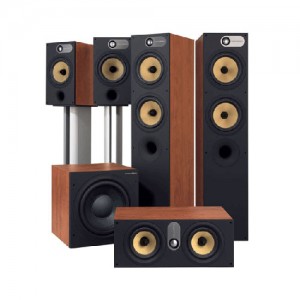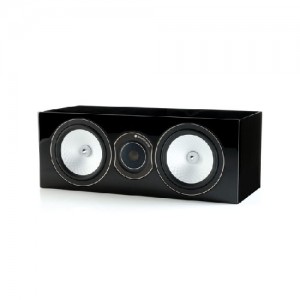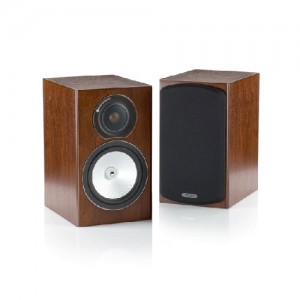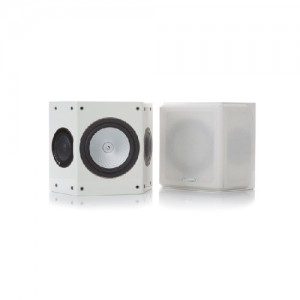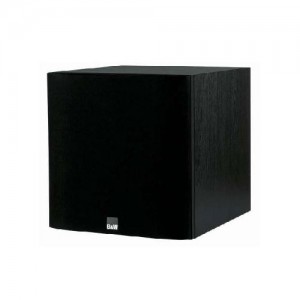Speaking loud & clear…
Part 2 of 3
Part two of Speaking Loud and Clear will be looking at suitable speakers for you A/V and your Home Cinema requirements. This includes ideal television speaker upgrades to full Home Theatre packages.
Home Cinema speakers can be used for your two-channel music. However, a Home Cinema is specifically set-up in order to mimic a cinema within your home. Your music should still sound great, but it may not be as accurate as that of a designated stereo Hi-Fi, purely designed for stereo programme reproduction. However, not everyone is able to have both a separate Home Cinema room and a Hi-Fi too. For many the living room acts as host to both the stereo and the television, with often AV receivers being used for both the stereo and the television or surround sound programmes.
Essentially surround sound applications require the speakers included to be designated for the surround effect, as opposed to providing perfect stereo reproduction.
To the left is a diagram which shows the ideal set-up of a basic 5.1 surround sound set-up. It also indicates an ideal number of degrees between speakers and their positioning too.
CENTRE:
Centre channel speakers are responsible for more than 90% of a surround-sound movie’s soundtrack. In other ways, it is sometimes referred to as the ‘dialogue speaker’ as most vocal activity is reproduced through the centre speaker, of which, should be placed in close proximity to the television screen.
MAIN FRONT, L&R:
The front speakers are placed on either side of the centre speaker. Their purpose is to reproduce the stereo parts of the surround track; these being left and right stereo channels. Like any stereo set-up, they should be placed an equal distance apart to create a realistic stereo field.
REAR SURROUND, L&R:
The rear left & right speakers are responsible for reproducing the surround channels of the soundtrack. The idea is that they then contribute to home cinema system by reproducing the little sound effects or adding emphasis to movie incidents, gunshots, explosions or planes coming into land, etc. These should be placed in opposite corners, equally spaced, and as far away from the front main speakers as physically possible.
SUBWOOFER:
Subwoofers are purely designated to creating the deep and booming bass that can often be more felt as opposed to being heard. The idea is to create the depth of bass found in explosions and car crashes, etc. The subwoofer creates more bass due to its design as opposed to the main speakers.
5 in 5.1 stands for the amount of loudspeakers in the system. .1 of 5.1 stands for the subwoofer, a self-contained speaker designated for ultra-low frequency responses. 7.1 Channel surround set-ups also include extra surround speakers. However, these are often more space consuming. 10.1 set-ups are also in the pipelines and due for a much greater audience in specialised Home Theatre applications. 5.1 was the earliest set-up to date is a very basic set-up which explains itself fairly well. Often enough with 5.1 set-ups are easy to find and to install. Yamaha is renowned for doing a very good value entry level kit in the form of their NSP20 5.1 speaker package. However, more advanced packages include B&W’s 684 package or Monitor Audio’s RX6 package, representing a higher-end speaker package.
In order to power the surround speakers you will need a suitable surround amplifier to power the speakers to their fullest potential. However, careful consideration and research is strongly advised to get the best sound possible, as we mentioned earlier in part 1 of Speaking Loud and Clear.
Upgrading your stereo television’s audio output is no trouble either. For those whom wish to upgrade sound in stereo, without a full surround Home Cinema set-up you have the option of 2.1 stereo. 2.1 comprises of two main L&R speakers and a subwoofer. The quality is dramatically improved as TV speakers are made only for reference as opposed to being full quality reproduction speakers. A 2.1 kit will help dramatically over the entire frequency range of the audio that you hear. Teac’s LSW300 is an ideal starting point, whilst the Elac Microstar BT offers amazing, unrivalled 2.1 television sound quality and Bluetooth connectivity too. These types of packages are also ideal for PC speaker upgrades.
Connecting your Home Cinema speakers should be performed in a careful manner, ensuring connections are made as they should be to avoid problems like phasing (loss of bass from incorrect terminal polarity connection) and even worse: short circuiting (caused from bare end wires touching the opposite polarity and causing the AV amplifier to short its output stages). To avoid any problems, we recommend a good quality speaker cable, as available from Hifi Gear, along with termination of the cables with banana plugs to minimise risks of connections becoming loose and shorting your equipment; we offer a termination service for a little extra with a majority of our cables.
In part 3 we will look at alternatives to full speaker packages and custom installation speakers for building projects.
